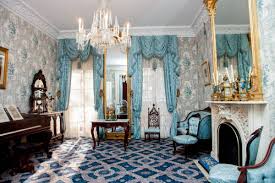My spouse and I visited the Theodore Roosevelt Birthplace
National Historic Site on a Saturday afternoon in mid-January 2017. This site,
managed by the National Park Service (NPS), is open Tuesdays through Saturdays
from 10:00 am until 4:00 pm, with 40-minute ranger-led guided tours every hour
on the hour for groups of 18 patrons. Although you cannot make a reservation
online for one of the free tours, you can stop in person and add your name to a
list earlier in the day. You can only view the period rooms on a guided tour,
although you are welcome to investigate the visitor center and browse the tiny
shop of souvenir items anytime.
The Roosevelt birthplace is located on East 20th Street (between Park Avenue South and Broadway) in
the Gramercy-Union Square Park/Flatiron neighborhood. Theodore
Roosevelt, the 26th president of the United States, was born on the
site in 1858. Although the house was
demolished in 1916 to make way for a retail building (shop and café), within
weeks of Roosevelt’s death, in 1919, the Women’s Roosevelt Memorial
Association, purchased both the lot on which the home had been located and the
adjoining lot in order to recreate his childhood home. The reconstructed home,
which resembles the interior design of the house during the years of 1865 to 1872,
was donated to the National Park Service in 1963.
The visitor center offers a 25-minute film that describes
the physical and emotional struggles that young “Teedie” endured while growing
up in the home. A small exhibit space displays informational placards and
photographs along with important memorabilia like Roosevelt’s Rough Rider
uniform, taxidermy specimens, teddy bear, police commissioner billy club,
shovelful of earth from the Panama Canal, and bullet-pierced shirt, manuscript,
and eyeglass case that saved his life during an assassination attempt. Many of
the displays were undergoing restoration on the day that we visited, which was
unfortunate. Also disappointing was the setup for the introductory film, which
was difficult to see and hear because of other noisy guests walking around the
perimeter of the room to view the display cases.
Guided tours view five historically furnished rooms in the
neo-Gothic brownstone, including many family-owned items. The neighborhood became fashionable in the
1840s, when six row houses were built on this block. Lawyer Theodore Roosevelt
Senior occupied the home next door to his publisher brother Robert Roosevelt (the
building that currently houses the exhibit/film space). The future president
was born in October 1858.
Guided tours view five historically furnished rooms in the
neo-Gothic brownstone, including many family-owned items. The neighborhood became fashionable in the
1840s, when six row houses were built on this block. Lawyer Theodore Roosevelt
Senior occupied the home next door to his publisher brother Robert Roosevelt
(the building that currently houses the exhibit/film space). The future
president was born at the 20th Street home in October 1858, where he
resided until 1873 when his family moved uptown to West 57th Street,
but the family continued to own Robert’s brownstone and leased it as a shop.
For a little more
history, Colonel Theodore Roosevelt worked as NYC’s commissioner of police and
created a famous reputation as a cavalryman by charging up San Juan Hill in
Cuba during the Spanish-American War. He was elected vice president under
William McKinley in November 1900. That September, an assassin murdered the
president, and the man now widely known as Teddy succeeded him.
We enjoyed our
visit to the Theodore Roosevelt Birthplace; it was a free and interesting way
to spend an hour or two.









No comments:
Post a Comment